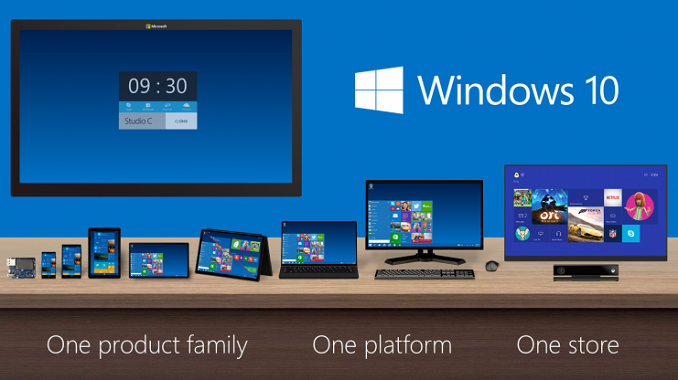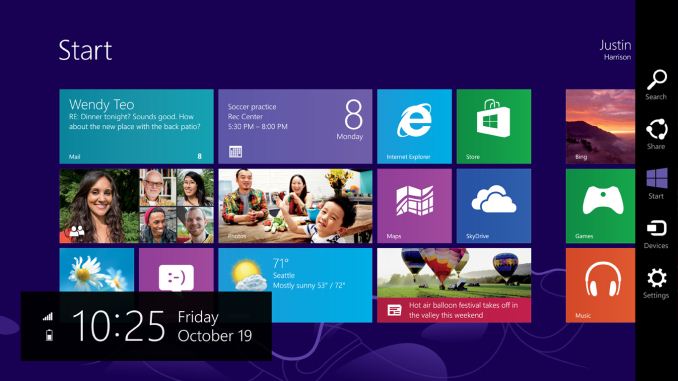Windows 10 Technical Preview First Impressions: The Return Of The Desktop
by Brett Howse on November 13, 2014 8:00 AM EST- Posted in
- Software
- Microsoft
- Windows 10

I’ve said this before, and I will reiterate it now. Windows 8, in general, is not perceived in a positive light. Not necessarily because of the lack of features, or even due to the touch first interface, but because from the start people did not buy into the paradigm. We can argue over why that was, and the specifics are likely different for every individual. But a big part of that was that Windows, which has had a familiar interface since Windows 95, had changed dramatically in look, feel, and general use. The traditional mouse and keyboard PC and notebook is a big part of the Windows user base, and especially at the beginning, Windows 8 did not cater to that crowd. While there were certainly improvements to the desktop, it was not enough to overcome the negative feelings of many users in regards to being productive on their PC. I say this as a fan of Windows 8.1, and I say this despite the positive review from this site. Windows 8 was an OS that worked, but had a steep learning curve that many people did not want to bother learning.
One of the biggest issues facing Windows 8 was just how much people liked Windows 7. Windows 7 was seen as the savior to Vista, and fixed many of its issues. But a lot of the initial problems with Vista were due to a major change in the driver model as well as the security model, which caused a lot of compatibility issues with older programs which expected administrator rights, as well as many hardware devices needed driver updates. With Windows 7, all of those changes were in the rear view mirror, allowing 7 to be a tweak of the overall UI and functionality rather than a rebuild of the OS from the ground up. With Windows 8, the move to touch first caused another dramatic upheaval. This time, rather than incompatible programs and hardware, we got a new Start Screen, a new runtime in WinRT, and a new app model with the Windows Store. For reasons that will never be made clear, the familiar start button was even removed, with the designers relying on hidden functions such as the hot corners to navigate around the OS with a mouse and keyboard. Luckily this change was reversed for Windows 8.1, with the start button returning, even if it still opened the Start Screen. With the Windows 8.1 Update, the system was made much more usable for a mouse and keyboard with the return of the menu bar to close apps, rather than dragging them down off the screen, and several other changes as well which brought the balance back somewhat to cover both touch interfaces as well as the mouse and keyboard.
 Windows 8 at launch in October 2012
Windows 8 at launch in October 2012
With Windows 8, Microsoft tried out an operating system which would work with a single interface across a breadth of hardware, from small form factor tablets, up to 30” monitor desktops. While they certainly succeeded in creating an interface that worked across all of those platforms, it was not ideally suited to any of them. With the tablet mode, the new Start Screen worked very well, and the charms menu and app switcher were fairly easy to use. But many of the settings and programs would be on the desktop, where touch only worked sparingly. Some desktop applications, such as Office, were created with a touch mode to increase the size of the onscreen elements, but overall the experience was subpar. Similarly, on the desktop, the touch interfaces were not ideal, and the hot corners certainly had issues especially on multi-monitor systems.
Windows 10 Technical Preview at launch
But now we come to Windows 10. Windows 10 is ditching the “One Interface to Rule them All” mentality, and moving to a more user friendly model of a single store across all platforms, and multiple interfaces to the same OS depending on the current usage model. We have not seen all of this in practice as of yet in the Technical Preview, but Microsoft has demonstrated their solution to this change in input mode with a feature they are calling Continuum.
The goal is that those that are on a keyboard and mouse based system will have the traditional start menu and desktop, with apps in windows, but if you are on a touch based device, or if you go on a 2-in-1 from keyboard to touch, the system will switch to the Windows 8 style start screen with full screen apps.
One of the keys to having this experience is an app model that allows a developer to target this different user interface paradigms. Microsoft’s solution to this is Universal Apps.











198 Comments
View All Comments
name99 - Saturday, November 15, 2014 - link
If they have any sense they will copy Apple (yet again, adding to the 90% of features that are currently Apple copies) and(a) warn when the user launches code that is unsigned
(b) not allow unsigned code to run without special (not completely obvious) interaction by this user.
This might do one bit more to help limit the spread of malware (especially the stuff that runs as non-obvious apps, like autorun apps on USB, or weird drivers, or stuff that gets downloaded from the net pretending to be a movie).
asmian - Sunday, November 16, 2014 - link
"they will copy Apple (yet again, adding to the 90% of features that are currently Apple copies)"No, you don't get away with that. You mean it's one of the 90% of features that Apple has stolen from others, then claimed to have invented, or fraudulently patented despite years of demonstrable prior art. Apple is the copier, not the innovator, and Jobs admitted it publicly. Some of us are old enough to remember the original Apple vs. MS spat over "look and feel" when Apple tried to prevent Windows from using a GUI at all, despite them having stolen the idea themselves from work done at Xerox Parc...
andrewaggb - Sunday, November 16, 2014 - link
I think you're trolling or you haven't used windows since xp. In my opinion at least, you get sufficient warnings for these activities.WinRT essentially has these restrictions.
DanNeely - Thursday, November 13, 2014 - link
"The Windows Store is going to be a big part of this, and if the rumors of desktop apps being integrated into the store is true, then the OOBE for Windows 10 will be amazing. All of your settings and apps will now follow you from device to device, with a single log in."Just offering desktop apps in the store isn't enough to do that. They also need to:
1) Convince desktop app developers to offer their apps in the store.
2) Allow paid apps originally bought outside of the store to be redistributed within it without requiring the purchase of a new copy.
3) For apps with regular paid upgrades keep all the historic versions available for redownload if a user hasn't bought the upgrade.
4) Find apps installed traditionally when a PC is upgraded and import them into the store system.
5) Provide a scan app that works on Win7/8.x and will generate a Windows store app download list to jumpstart your new Windows 10 system.
kmmatney - Thursday, November 13, 2014 - link
How many Windows "Apps" do people normally buy? I buy games from Steam, but almost all of my Apps are freeware. I buy Apps for my phone,as sometimes they offer a better experience than a webpage, but on a desktop you can just use the browser instead of Apps.Icehawk - Thursday, November 13, 2014 - link
Please tell me W10 will stop asking me to "tap here" when I connect a Bitlocked drive to my desktop... which has no touchscreen. W7's implementation was much better, a normal popup window I could begin typing my password into.mkozakewich - Thursday, November 13, 2014 - link
It's not a sharp difference between "Touch" and "Mouse and Keyboard". Any touch system can have mice and keyboards attached. The mouse and the keyboard are two separate control schemes, too, and each have to be able to work independently.In the first part, you go on at length about how Windows 8 failed from a "Mouse and Keyboard" view. I understand that it was weird to use a mouse before 8.1, but there honestly hasn't really been a change between keyboard use. The Windows key didn't disappear from all the keyboards, nor did it start working. The same commands would switch between windows and close windows. It was still as easy to select things.
It would have been more succinct to say, "Windows 8 designed on-screen interactions for touch, to the detriment of the mouse."
mkozakewich - Thursday, November 13, 2014 - link
Whoops, "nor did it stop working."synoptic12 - Thursday, November 13, 2014 - link
Irrespective of the many view points on the Windows 10 features, the fact remains that the focal point is centered upon a universal value, (Icons) whereas no effort is being infused to use one's mind. The continuum can be considered to simplify the apps for the generation who can not comprehend, or think. Many believe that a network is comprised of magical symbols which really serve no purpose, just delving upon grade school functions. We're not getting smarter, we're moving into a dilemma of lacking any thought.theuglyman0war - Thursday, November 13, 2014 - link
but so many devs can hope to get rich quick now that my gui looks like corporate web advertising. I wonder when the bottom falls out from app selling and App stores if the majority will act like they did not see it coming.